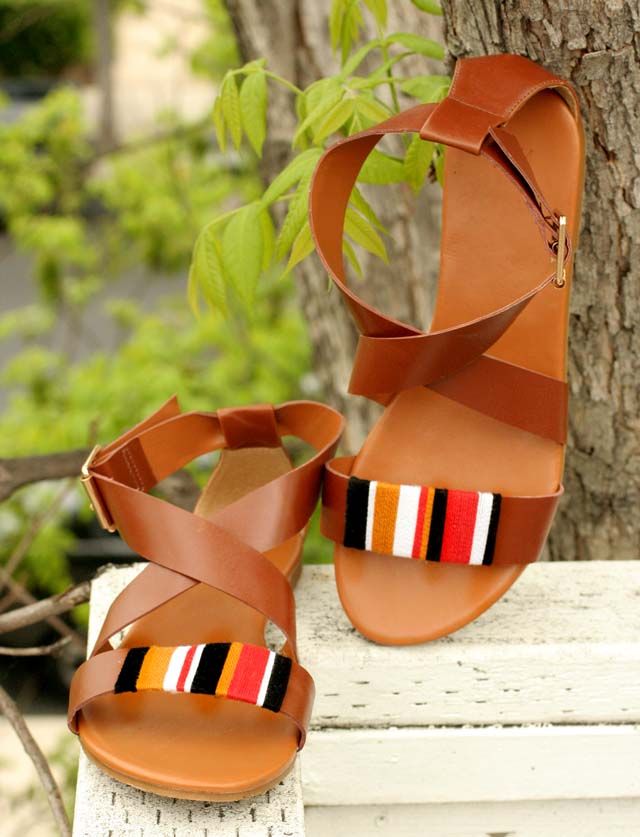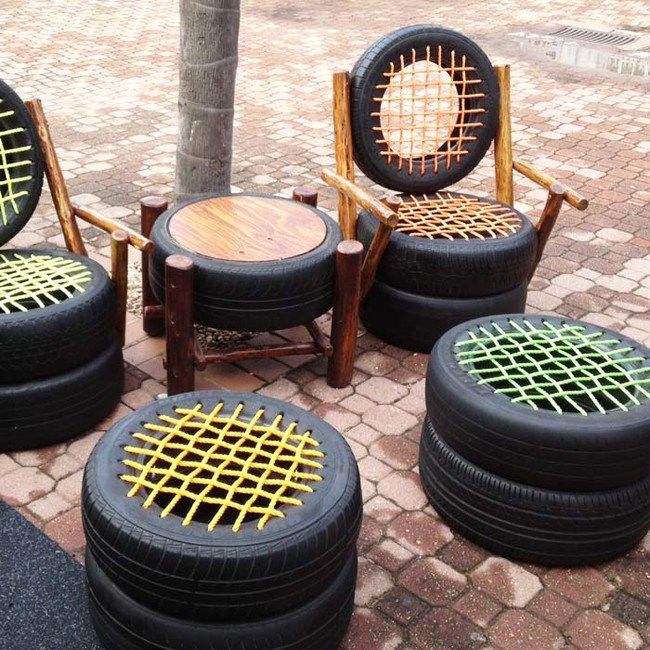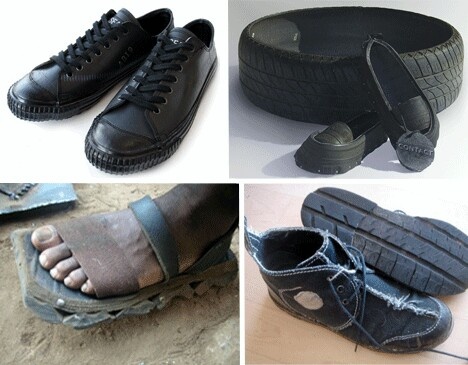Etsy is no longer supporting older versions of your web browser in order to ensure that user data remains secure. Please update to the latest version.
Take full advantage of our site features by enabling JavaScript.
(181 relevant results)
| Make Your own Tire Sandals I'm hard on shoes. It's not uncommon for me to go through half a dozen pairs of shoes, or more, each year. I maintain an active lifestyle, hiking, playing, camping, and working. Water wears out a shoe quicker than anything else. A few trips in and out of the creeks, puddles, and swamps, and they just come unglued. If I do not happen to dissolve my shoes in water, then I wear out the soles on gravel. It has always amazed me that tire companies can manufacture a tire and warranty the tread for some 50,000 miles, yet I can wear out the sole on any ordinary shoe in less than a year. How come we cannot buy a shoe with a 50,000 mile warranty? Really, I have never been quite satisfied with conventional shoes, and it's not just because I wear them out so easily. While I am at it, I have other complaints too. You see, I do a lot of primitive camping, building my own shelters, starting fires without matches, gathering wild foods--that sort of thing. To me this type of camping is a way of getting close to nature, by participating in nature, instead of merely camping in it. I like to touch nature, and I feel so removed in a pair of ordinary shoes. I go barefoot as much as I can, but like most people, I have tender feet--because I don't go bare foot all the time. I may practice primitive camping, but I also have to face the modern realities of the clock. My camping trips are typically short, and full. I always have a lot of things I want to do while I am out. To solve that problem, I have tried over the years many marriages between buckskin and rubber to make lasting soles on my moccasins. The "paint-on" sole, a mixture of ground up tires and Barge Cement glue, does not work all that well. It helps, but even that wears through quite quickly under harsh conditions, and the rubber coating makes it difficult to dry out the leather of the moccasins. More so, they are not very patchable once a hole gets started. I have also tried working with the "crepe soles", a thick sheet of rubber cement that you can buy, cut, and glue to the bottoms of shoes. The problem I had with these is that my foot no longer stayed in the right place on my moccasins. My foot was typically sliding off the back edge of the sole. After all these life-long problems with shoes, I was ecstatic to learn of something that actually did work. My friend Jack Fee and I were preparing to go out on a three-week expedition in the mountains. Jack then told me a story about Indians from Mexico coming to the United States and winning foot races in sandals cut from tires. I've been interested in using tire soles before, but it seemed like I would have to glue or stitch the tire to the moccasins. I had reason to doubt that it would work. I also once had a pair of tire sandals, made in Mexico, where the leather lacing was nailed to the tire soles. Those came apart within a couple of days. Jack had never seen the tire sandals that were reportedly used by the Mexican Indians, but decided to see what he could do anyway. I was most impressed with the fact that there was no glue, and no stitching or strapping on the bottom of the sole where they would be exposed to the ground. Instead he cut the sole with some side tabs out of the tire as one contiguous piece. The first model was a little crude in appearance, but was amazingly comfortable. I too had to make a pair for the expedition. The field tests of our sandals were quite exciting. The tire sandal and moccasin combination meant we had "modular" shoes. We wore both the moccasins and the soles when hiking, and then just one or the other around camp. We could use just the moccasins for stalking, or just the tires for walking in water. We climbed 10,000 foot peaks twice and generally just put on the miles. I did not wear socks, and never washed my moccasins, but my feet were in healthy condition for the duration of the trip-- a first for me. We did find that we would get blisters if we wore just the tires for any significant hiking, but we seemed to have no problems when the tires were worn in combination with moccasins, or with a couple pairs of heavy socks. I was amazed at how comfortable these sandals were, particularly because I once wore conventional hiking boots on a 500 mile walk across Montana, with severe blistering for the first 250 miles of the trip. Our new type of footwear gave me a freedom and comfort I had been searching for for a decade. Our prototype sandals were crude, but effective. Since then, I have developed the idea some more, into the tire sandals shown in these pictures. The most significant modification was the addition of the tab at the very back of the sandals. That tab is not normally necessary, except in water. Without it your feet tend to slide forward off the front of the soles when the tires are wet. That back tab holds your foot securely in place. I also added the rubber buckles, and did away with the rope and buckskin ties of our early models. Also for our prototypes we just traced around a pair of conventional Tevas onto a tire, and started from there. I have since developed a system for creating a pattern to match your own foot. Plan on spending most of an entire day making your first pair. You will get faster as you make more. Making Your Tire Sandals First, place either foot in the center of a large piece of paper, at least an 8 1/2 x 14. Trace around your foot, being careful at all times to keep the pencil straight up and down. Next make a mark on each side, directly down from the point on your ankles (A) (see pattern at the end of this web page). Also make a mark at the point along the inside of your foot, directly back from your big toe (B). Remove your foot from the pattern. Now sketch a bigger outline around the tracing of your foot. Add about 3/8 inch for the toes and sides, but not to the back. Then use a ruler and bisect the pattern lengthwise, extending the line three inches past the heel. The positioning of all these tabs is quite variable, and you can choose to move them forward or back, or at angles to one another, and all usually work, although the arrangement I have suggested may work more consistently. Problems usually arise with the front set of tabs. When at angles across the pattern they can twist a little and dig into your foot. If the tabs are moved forward or back then the edges can dig into that point (B) on the inside of your foot. That point is more pronounced on some people's feet than on others. Now sketch in the five tabs, as shown on the pattern. As for tires, I would recommend truck tires, rather than car tires. The "corner" of any tire, where the sidewalls and tread come together, is always much thicker than the rest. You can work with that thickness in the tabs of the sandals, but not in the sole itself. Pickup tires are typically wide enough to work with, and you can make about three pair of sandals from one tire. Most importantly, always use tires that do not have steel cables running through them. We used simple utility knives to cut out our first sandals. Doing it this way you can trace around the pattern on the outside of the tire and start cutting. However, I must say this is very laborious and not much fun. It is hard work, and you could easily slip and cut yourself with the utility knife. Along the way I have discovered that it is much easier and more enjoyable to cut tires using sharp wood chisels or a bandsaw. To do the chisel or bandsaw method you must first remove a section of tire. This allows you to run the piece through the bandsaw, or to put it on a wooden block, where you can chisel from the inside out. A circular saw works fairly well for cutting tires, except that it creates a lot of blue-black smoke, and binds frequently. Cut out a piece that is at least a half inch longer than your pattern, and save as much of the sidewalls as you reasonably can. These are useful later for making the buckles. Do not try cutting through the inner edge of the tire, which has an imbedded steel band to fit the tire snug against the rim. Now, trace the pattern on the inside of the tire, being certain that the pattern is centered and straight on the tire. Even a slight 1/2 inch angle along the length of a sandal can cause problems when you wear it. I've done separate tests, cutting out the sandals with chisels and with a bandsaw, and the bandsaw method is only a little faster. A good set of wood chisels works just fine if you do not have the bandsaw. I would suggest making only one sandal at a time, and completing it. Finish the one and try it on; you might think of some modifications to improve the next one. The next step, after cutting out the sandal, is to thin the four side tabs. The tabs are generally cut from that "corner" on the tire, where there is a thick lump of tread. These are easiest to thin on a bandsaw. You can, however, do a crude but adequate job by cutting the lump down with some careful chiseling or with a sharp knife. Thin down as close as you can to the nylon/rayon plies, without actually cutting any of them. This step is not easy by any method I have found, and I typically leave 1/8 to 1/4 inch of rubber covering the plies, for a total thickness of up to half an inch. That is still quite thick, but thin enough to work. Now, to make the tabs flex upward, take a razor blade and slice straight into the tread of the tire at the joint where the tab attaches. Slice in all the way until the plies inside are exposed. Be careful not to cut into those fibers. Chisel out each of the eyelets, where the strapping will be threaded through. For this I use a 1 inch chisel and a 1/4 inch chisel. Be careful to not cut too close to the edge. If you break out the side of a tab, then you generally have to start all over. Also cut a set of buckles from the sidewalls of the tire. These are easy to do. For strapping, I use a sort of a nylon harness strapping, available at farm and ranch supply stores. 3/4 inch wide strapping works well with the one inch slots. Cut pieces that are extra long, you can trim them off after you thread them through. Use a match, and melt the end of the nylon strap to secure the threads. To do the back strap, thread through the hole marked point (C) on the pattern and stitch an inch or so of the strap back on itself. Thread around through the other eyelets, through the buckle, through the other hole on the first tab, and once again through the buckle. The front strap should be threaded through the buckle, through both eyelets, and back through the buckle again. The finished sandals should be comfortable to wear, although you may need to do some fine-tuning to get them right. For any serious hiking you should wear a couple heavy pairs of socks, or moccasins, or bring along some moleskin. Hi, Ernie
Go to The Art of Nothing Wilderness Survival Video Series Return to the Primitive Living Skills Page To purchase tire sandals, see: |
06/27/2020 19:48
There are many useful things you can do with old car tires. But you probably didn’t know that they make great summer sandals - comfortable and waterproof. Make yourself the same sandals with your own hands and enjoy the result.
Materials and tools needed:
Create a pattern on cardstock or heavy paper. Place your foot in the center of the template, mark the center of the foot, the first joint of the little toe, the center of the ankle inside and out. These are the points for the slots for the belts.
The first gap starts at the little finger mark and goes back. The second slot is 1 cm away from the first. On the ankle, the first 2 cuts are centered on the mark and separated by 1 cm. These are slots for a right triangle with the apex pointing into the template. The next 2 slots are at right angles to the lead slot just made and are parallel to each other.
On the ankle, the first 2 cuts are centered on the mark and separated by 1 cm. These are slots for a right triangle with the apex pointing into the template. The next 2 slots are at right angles to the lead slot just made and are parallel to each other.
The center line can be found by finding the center point between the ankle marks and the center point between the ball of the foot and little toe marks. Connect the two points with a straight line extending it to the edge of the template. Then cut out the template.
Do not use tires with steel belts (it is extremely dangerous to cut them). Regular spares are much better. Remove wheel and bead. This can be done by drilling a hole in the side wall. Then cut the tire across the tread into pieces that are slightly longer than the template.
First find the center of the tread at both ends of the section and mark. Then transfer these marks to the inside of the tire. Next, connect the marks with a straight line. Align the center line of your template with the center line on the inside of the tire.
Align the center line of your template with the center line on the inside of the tire.
Cut out the contour sole using a spiral or band saw. Make holes for the straps. Their position is easily transferred: the template on top is cut with a chisel to leave a mark on the sole.
Cut 12 straps from the bike tube. Insert the straps into the slots with a screwdriver.
Make straps according to the photo. The straps will fit snugly in the slots.
To adjust them, pull the belt in both directions to make it thinner. Then it will be easier to slide in the slot in the right direction.
This is an optional hack, but it is recommended to secure the straps with shoe glue. After bending the sole so that the slots open slightly, squeeze the glue into the slot. Once it dries, you can remove the excess tape.
Wear your new sandals anywhere! Get inspired for new projects.
Tires that have fallen into disrepair can be made not only graceful swans that adorn some yards. We found other ideas too!
Pavel Gorbachev
Tags:
Helpful Hints
Tires
Pixabay
All you need is a knife, nails and a hammer. The sidewall of the tire is cut off on one side. Outside, a sheet of rubber is nailed around the circumference of the hole, the remains are cut off. The ends of the nails are bent from the inside. The resulting container is turned inside out and on the reverse side, the sidewall cut off at the very beginning is nailed on top. This is how a tub with a base is obtained. Loops made of rubber strips can be nailed to it with nails on both sides, the ends of the nails can be bent. Lohan is ready!
Lohan is ready!
The tire is folded into strips about 2 cm wide, only the tread part is needed. The sidewalls are cut in half, the base of the chair is knocked down from the four sidewalls with the help of nails. One whole sidewall is nailed to the crescents on top. On the resulting base of the chair, rubber strips are nailed through the gap, forming a soft seat. But that's not all. Stripes are woven across the gaps, which are also nailed to the circumference.
This creates a wicker checkerboard seat. The sidewall is still nailed on top so that the nail heads are not visible. From one whole sidewall, bent in an arc, the frame of the back of the chair is assembled, which is nailed to the base. A wicker back is assembled with strips of rubber using a similar technology. Half of the sidewall is nailed along the perimeter of the back to hide the nail heads. Sit down please!
The upper part of the tire with a tread is cut to fit the foot, on the left and right soles.